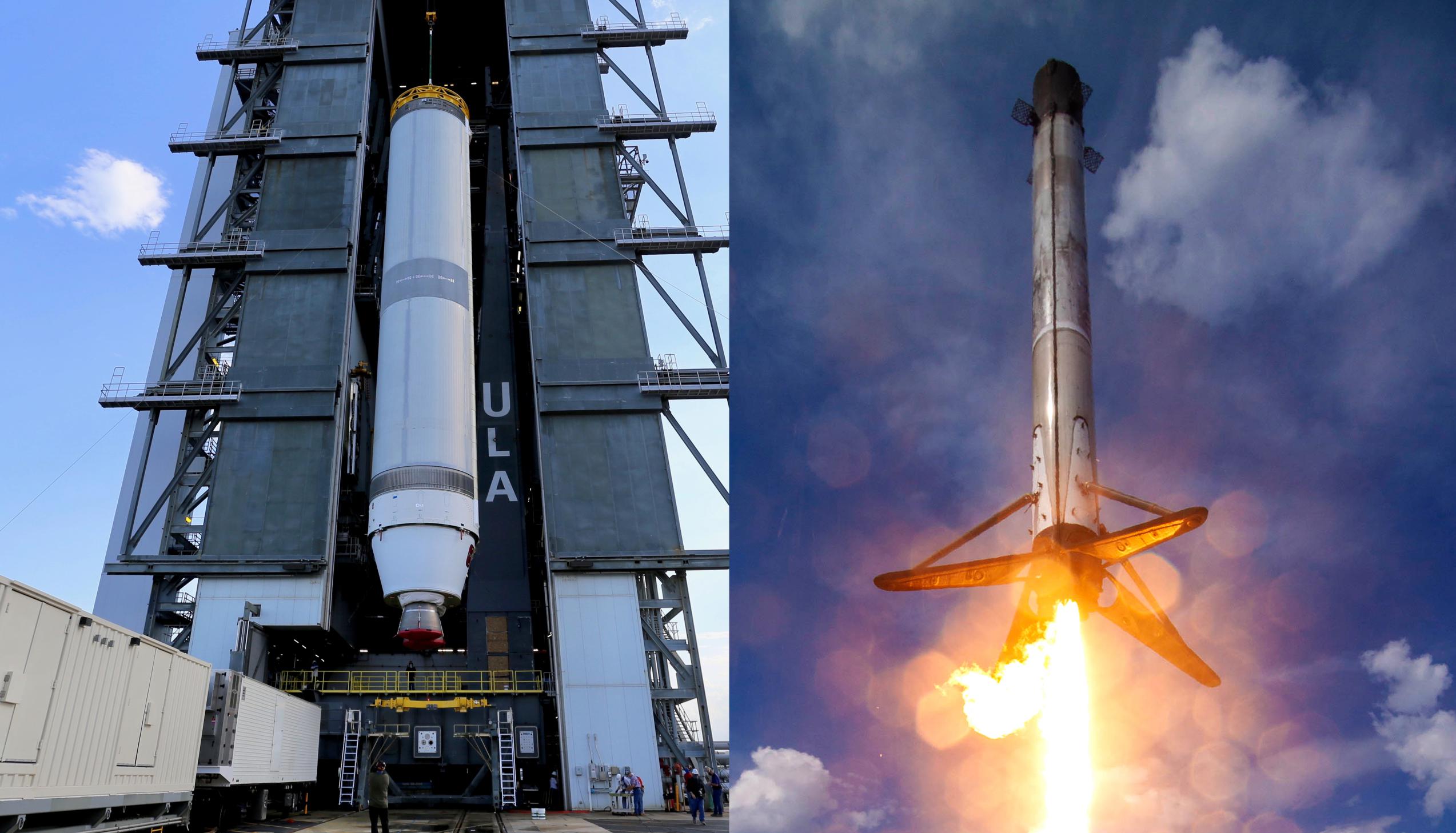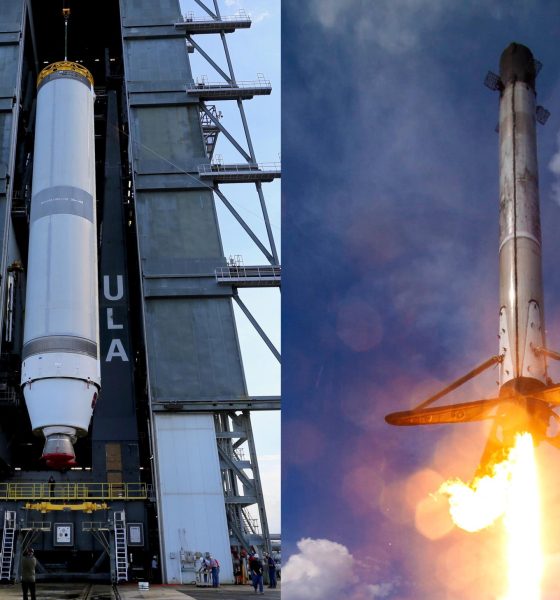

News
SpaceX CEO Elon Musk’s hat is safe after ULA Vulcan rocket launch slips to 2023
In the latest unfortunate development for SpaceX competitor United Launch Alliance’s next-generation Vulcan Centaur rocket, it looks like CEO Elon Musk may have been right all along when he forecast major delays more than three years ago.
In February 2018, even before SpaceX had flown Falcon Heavy for the first time, detractors with axes to grind were already busy attempting to downplay the rocket’s capabilities. On February 6th, Falcon Heavy lifted off for the first time, launching a several-ton Tesla Roadster car into interplanetary space and marking the first debut of a super heavy-lift rocket since the 1980s. That successful launch also meant that ULA’s last bastion of competitive advantage – the Delta IV Heavy rocket, fittingly by way of monopoly – was no longer alone.
Indeed, mere months after its near-flawless debut, Falcon Heavy had already secured its first operational US military launch contract. Delta IV Heavy, on the other hand, had already been preparing for retirement as part of ULA’s plan to replace two complex rockets (Delta and Atlas) with Vulcan.
Musk mercilessly took to task ULA’s heavy-lift rocket when commenters brought it up, noting that Falcon Heavy is largely comparable in a partially-reusable configuration but completely outclasses Delta IV Heavy – while still being dramatically cheaper – if all boosters are expended. The SpaceX CEO estimated that Delta IV Heavy launches would cost ULA significantly more than $400M after the company had effectively announced the end of Delta IV Medium production, though ULA CEO Tory Bruno still claimed a launch price of ~$350M.
In response to a reply noting that ULA’s plan was to replace Atlas V and Delta IV with Vulcan Centaur for launches “after 2020,” Musk pulled no punches, stating that he would “seriously eat [his] hat with a side of mustard if [Vulcan] flies a national security spacecraft before 2023.” At the time, ULA’s CEO did not exactly seem to share Musk’s shocking appraisal of the situation, which was out of left field even for major SpaceX proponents.
At the time, ULA’s party line touted Vulcan Centaur lifting off for the first time in late 2019 – the very next year. Ironically, weeks after Musk threw down his hat-eating gauntlet, ULA announced that Vulcan’s first launch had slipped to “mid-2020” – with a second flight later the same year – to give the company time to move straight to a larger upper stage originally meant to debut later on. Six months later, ULA announced yet another delay for Vulcan, this time pushing the rocket’s launch debut from mid-2020 to no earlier than (NET) April 2021.
Three years later, April 2021 has come and gone and ULA’s latest public Vulcan launch target is now “late 2021,” though that is all but guaranteed to slip into early 2022. In the latest (not-so-) shocking development for ULA’s next-generation rocket, the company has now requested and received permission from the US military to swap out Vulcan for an Atlas V rocket on what would have been the vehicle’s first military launch.
Exercising a contract loophole that had to have been explicitly designed to give ULA – and ULA alone – the option to fall back on its Atlas V or Delta IV rockets if Vulcan were to experience major delays, Atlas V will now take over the ULA’s USSF-51 mission. As a result, Vulcan Centaur’s first dedicated ‘national security’ launch is now officially scheduled no earlier than 2023, saving Elon Musk from having to eat his hat.
As of May 2021, ULA has now replaced one Vulcan launch with an Atlas V and inexplicably closed nine Atlas V launch contracts with Starlink competitor Amazon, bringing into question whether the company is ever actually going to simplify its rocket production lines. Given that ULA no longer appears to be planning on reusing parts of Vulcan, the only possible way Vulcan will end up more affordable than the rockets its replacing is if it quickly becomes the only rocket ULA produces, which was originally the plan. With ULA now apparently going out of its way to sell Atlas V commercially instead of Vulcan Centaur, it’s difficult to argue that the company has any interest at all in lowering the cost of access to space or offering SpaceX serious competition outside of lobbying and greasing the hinges of revolving doors.

News
Tesla FSD fleet is nearing 7 billion total miles, including 2.5 billion city miles
As can be seen on Tesla’s official FSD webpage, vehicles equipped with the system have now navigated over 6.99 billion miles.

Tesla’s Full Self-Driving (Supervised) fleet is closing in on almost 7 billion total miles driven, as per data posted by the company on its official FSD webpage.
These figures hint at the massive scale of data fueling Tesla’s rapid FSD improvements, which have been quite notable as of late.
FSD mileage milestones
As can be seen on Tesla’s official FSD webpage, vehicles equipped with the system have now navigated over 6.99 billion miles. Tesla owner and avid FSD tester Whole Mars Catalog also shared a screenshot indicating that from the nearly 7 billion miles traveled by the FSD fleet, more than 2.5 billion miles were driven inside cities.
City miles are particularly valuable for complex urban scenarios like unprotected turns, pedestrian interactions, and traffic lights. This is also the difference-maker for FSD, as only complex solutions, such as Waymo’s self-driving taxis, operate similarly on inner-city streets. And even then, incidents such as the San Francisco blackouts have proven challenging for sensor-rich vehicles like Waymos.
Tesla’s data edge
Tesla has a number of advantages in the autonomous vehicle sector, one of which is the size of its fleet and the number of vehicles training FSD on real-world roads. Tesla’s nearly 7 billion FSD miles then allow the company to roll out updates that make its vehicles behave like they are being driven by experienced drivers, even if they are operating on their own.
So notable are Tesla’s improvements to FSD that NVIDIA Director of Robotics Jim Fan, after experiencing FSD v14, noted that the system is the first AI that passes what he described as a “Physical Turing Test.”
“Despite knowing exactly how robot learning works, I still find it magical watching the steering wheel turn by itself. First it feels surreal, next it becomes routine. Then, like the smartphone, taking it away actively hurts. This is how humanity gets rewired and glued to god-like technologies,” Fan wrote in a post on X.
News
Tesla starts showing how FSD will change lives in Europe
Local officials tested the system on narrow country roads and were impressed by FSD’s smooth, human-like driving, with some calling the service a game-changer for everyday life in areas that are far from urban centers.

Tesla has launched Europe’s first public shuttle service using Full Self-Driving (Supervised) in the rural Eifelkreis Bitburg-Prüm region of Germany, demonstrating how the technology can restore independence and mobility for people who struggle with limited transport options.
Local officials tested the system on narrow country roads and were impressed by FSD’s smooth, human-like driving, with some calling the service a game-changer for everyday life in areas that are far from urban centers.
Officials see real impact on rural residents
Arzfeld Mayor Johannes Kuhl and District Administrator Andreas Kruppert personally tested the Tesla shuttle service. This allowed them to see just how well FSD navigated winding lanes and rural roads confidently. Kruppert said, “Autonomous driving sounds like science fiction to many, but we simply see here that it works totally well in rural regions too.” Kuhl, for his part, also noted that FSD “feels like a very experienced driver.”
The pilot complements the area’s “Citizen Bus” program, which provides on-demand rides for elderly residents who can no longer drive themselves. Tesla Europe shared a video of a demonstration of the service, highlighting how FSD gives people their freedom back, even in places where public transport is not as prevalent.
What the Ministry for Economic Affairs and Transport says
Rhineland-Palatinate’s Minister Daniela Schmitt supported the project, praising the collaboration that made this “first of its kind in Europe” possible. As per the ministry, the rural rollout for the service shows FSD’s potential beyond major cities, and it delivers tangible benefits like grocery runs, doctor visits, and social connections for isolated residents.
“Reliable and flexible mobility is especially vital in rural areas. With the launch of a shuttle service using self-driving vehicles (FSD supervised) by Tesla in the Eifelkreis Bitburg-Prüm, an innovative pilot project is now getting underway that complements local community bus services. It is the first project of its kind in Europe.
“The result is a real gain for rural mobility: greater accessibility, more flexibility and tangible benefits for everyday life. A strong signal for innovation, cooperation and future-oriented mobility beyond urban centers,” the ministry wrote in a LinkedIn post.
News
Tesla China quietly posts Robotaxi-related job listing
Tesla China is currently seeking a Low Voltage Electrical Engineer to work on circuit board design for the company’s autonomous vehicles.

Tesla has posted a new job listing in Shanghai explicitly tied to its Robotaxi program, fueling speculation that the company is preparing to launch its dedicated autonomous ride-hailing service in China.
As noted in the listing, Tesla China is currently seeking a Low Voltage Electrical Engineer to work on circuit board design for the company’s autonomous vehicles.
Robotaxi-specific role
The listing, which was shared on social media platform X by industry watcher @tslaming, suggested that Tesla China is looking to fill the role urgently. The job listing itself specifically mentions that the person hired for the role will be working on the Low Voltage Hardware team, which would design the circuit boards that would serve as the nervous system of the Robotaxi.
Key tasks for the role, as indicated in the job listing, include collaboration with PCB layout, firmware, mechanical, program management, and validation teams, among other responsibilities. The role is based in Shanghai.
China Robotaxi launch
China represents a massive potential market for robotaxis, with its dense urban centers and supportive policies in select cities. Tesla has limited permission to roll out FSD in the country, though despite this, its vehicles have been hailed as among the best in the market when it comes to autonomous features. So far, at least, it appears that China supports Tesla’s FSD and Robotaxi rollout.
This was hinted at in November, when Tesla brought the Cybercab to the 8th China International Import Expo (CIIE) in Shanghai, marking the first time that the autonomous two-seater was brought to the Asia-Pacific region. The vehicle, despite not having a release date in China, received a significant amount of interest among the event’s attendees.








